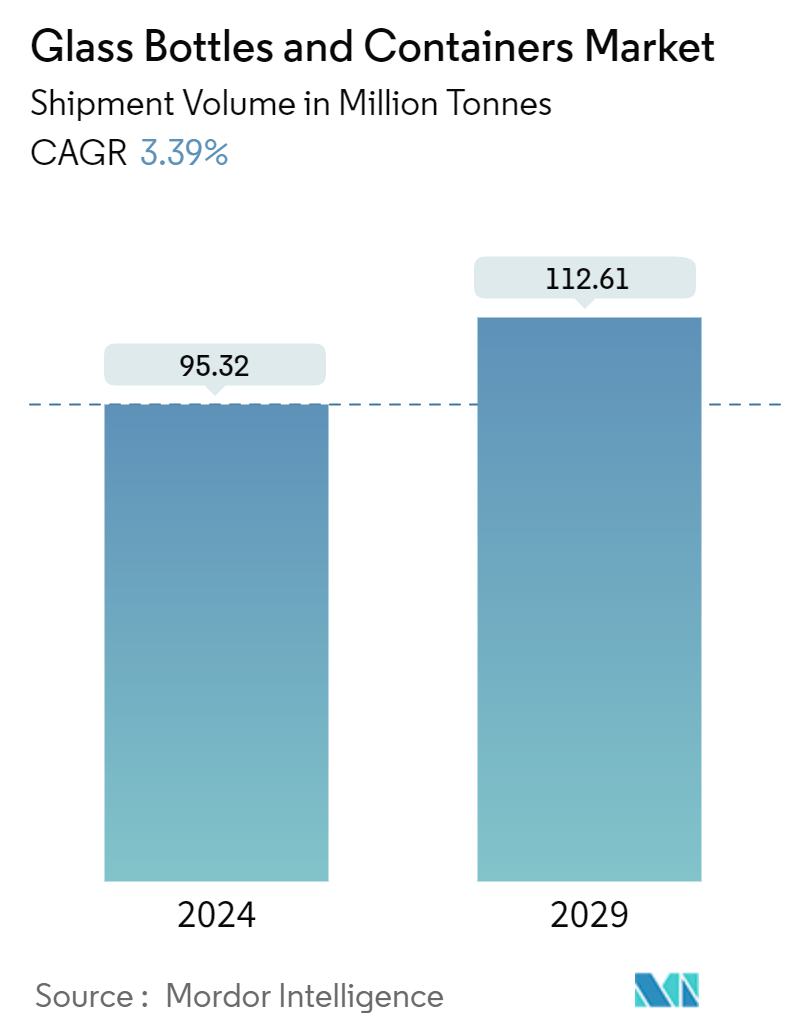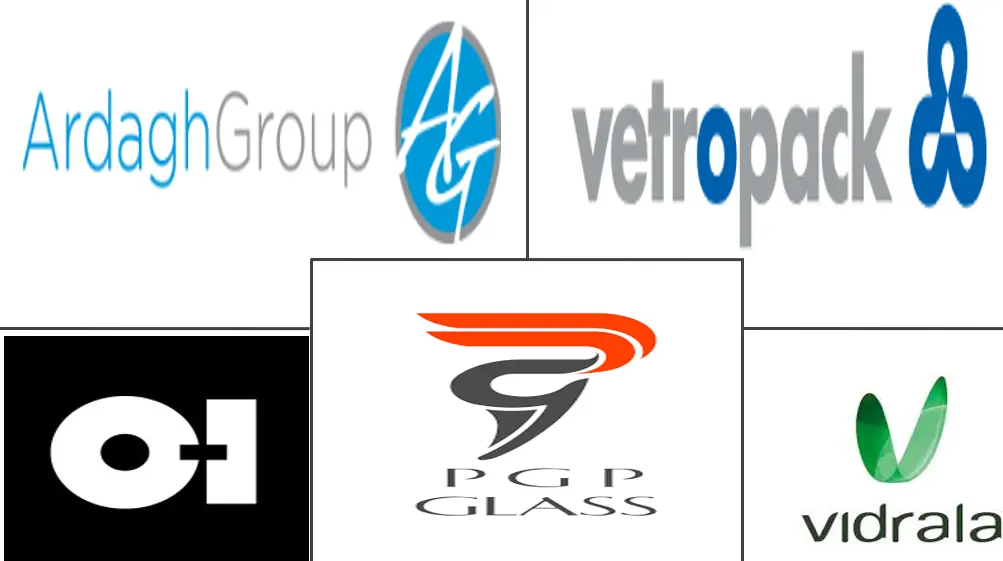Market Size of Glass Bottles And Containers Industry

| Study Period | 2019 - 2029 |
| Market Volume (2024) | 95.32 Million tonnes |
| Market Volume (2029) | 112.61 Million tonnes |
| CAGR (2024 - 2029) | 3.39 % |
| Fastest Growing Market | Asia Pacific |
| Largest Market | Europe |
| Market Concentration | Low |
Major Players
*Disclaimer: Major Players sorted in no particular order |
Container Glass Market Analysis
The Glass Bottles And Containers Market size in terms of shipment volume is expected to grow from 95.32 Million tonnes in 2024 to 112.61 Million tonnes by 2029, at a CAGR of 3.39% during the forecast period (2024-2029).
- Growing consumer demand for safer and healthier packaging is fueling the expansion of glass packaging across diverse categories. Cutting-edge technologies, including embossing, shaping, and artistic finishes, are boosting the allure of glass packaging for end users. Furthermore, the rising appetite for eco-friendly products, combined with a thriving food and beverage sector, is driving the container glass market's growth.
- Recently, a significant movement towards transparency in food packaging has emerged. Glass bottles and transparent containers, celebrated for their timeless elegance, resonate strongly with consumers. In light of this trend, companies globally are increasing their production capacities. For example, in February 2024, Arglass, a manufacturer of glass containers, secured over USD 230 million in funding to set up a second furnace at its Georgia campus in the U.S. This facility, slated to commence operations in Q2 2025, is projected to churn out over 350 million sustainable glass containers each year.
- Prominent players in the glass packaging sector encompass Owens-Illinois, Veralia, Ardagh Glass, Vidrala, BA Vidro, and Gerresheimer, among others. These leading manufacturers hold a significant stake in the global market, thanks to their vast production capacities spread across the globe. As a case in point, Ardagh Group, a key global player in sustainable and infinitely recyclable glass packaging, boasts 61 production facilities in 16 countries and is actively broadening its presence in the glass packaging landscape.
- Yet, glass packaging isn't without its hurdles. The inherent fragility of glass bottles and containers demands careful handling throughout operations and logistics. This delicacy complicates transportation, requiring specialized care. Shipping firms are compelled to adopt specific packaging and shipping techniques to guarantee the safe delivery of glass items. Additionally, the carbon footprint linked to glass manufacturing presents another hurdle to the market's expansion.
- Nonetheless, a surge in awareness regarding sustainable packaging, especially in the wake of the pandemic, hints at significant growth prospects in this sector. Emphasizing this momentum, Verallia, the globe's third-largest producer of glass packaging for food and beverages, rolled out an ambitious strategy in May 2024 to curtail CO2 emissions. The firm is eyeing a 46% cut in direct CO2 emissions by 2030 (compared to 2019 benchmarks) and is setting its sights on achieving carbon neutrality by 2050.
Container Glass Industry Segmentation
Glass containers market tracks the demand of glass packaging containers and bottles across the end-users industries including beverage, food, pharmaceutical, cosmetics and others. Glass containers are majorly used in the alcoholic and non-alcoholic beverage industry due to their ability to maintain chemical inertness and sterility and non-permeability.
The Container Glass market is segmented by end-user vertical (beverages [alcoholic (beer and cider, wine & spirits, and other alcoholic beverages] and non-alcoholic [carbonated soft drinks, milk, and water and other non-alcoholic beverages]), food, cosmetics, pharmaceutical, and other end-user verticals) and by geography (North America [United States and Canada], Europe [France, Germany, Italy, United Kingdom, Spain, Poland, Russia, Nordic and Rest of Europe], Asia-Pacific [China, India, Japan, Thailand, New Zealand and Australia, South Korea, Indonesia, Vietnam, and Rest of Asia -Pacific], Middle East and Africa [United Arab Emirates, Saudi Arabia, Egypt, Kuwait, South Africa, Nigeria, Morocco, and Rest of Middle East and Africa] and Latin America [Brazil, Mexico, Colombia, Chile, Argentina, and Rest of Latin America]). The market sizes and forecasts are provided in terms of consumption volume (tonnes) for all the above segments.
| By End-user Vertical | ||||||||||||
| ||||||||||||
| Food | ||||||||||||
| Cosmetics | ||||||||||||
| Pharmaceutical (Excluding Vials and Ampoules) | ||||||||||||
| Other End-user Verticals |
| By Geography* | |||||||||||||||||
| |||||||||||||||||
| |||||||||||||||||
| |||||||||||||||||
| |||||||||||||||||
|
Glass Bottles And Containers Market Size Summary
The glass bottle and container industry is experiencing a notable expansion, driven by increasing consumer preferences for safe and eco-friendly packaging solutions. The demand for glass packaging is bolstered by its appeal in the food and beverage sector, where transparency and aesthetic appeal are highly valued. The industry's growth is further supported by innovative technologies that enhance the design and functionality of glass containers, making them more attractive to consumers. The healthcare sector also contributes to this growth, with rising disposable incomes and the increasing prevalence of diabetes driving the demand for glass bottles used in pharmaceuticals. However, challenges such as the fragility of glass and its unsuitability for long-distance transportation due to weight and bulkiness remain significant hurdles for the industry.
The market is characterized by a competitive landscape dominated by major players like Gerresheimer AG, Owens-Illinois, Ardagh Packaging Group, and Piramal Glass Ltd, who maintain diverse product portfolios and a strong market presence. These companies are investing in sustainable practices and innovative packaging solutions to maintain their competitive edge. The wine and spirits sectors are particularly influential, with glass packaging being the preferred choice due to its ability to offer a premium experience and protect the contents from light exposure. The Asia-Pacific region, especially China and India, presents significant growth opportunities due to the rising consumption of alcoholic and non-alcoholic beverages. The industry's focus on sustainability and innovation, coupled with strategic investments, is expected to drive further growth in the coming years.
Glass Bottles And Containers Market Size - Table of Contents
-
1. MARKET INSIGHTS
-
1.1 Market Overview
-
1.2 Export-Import Data of Container Glass
-
1.3 Industry Standard and Regulation For Container Glass Use For Packaging
-
1.4 Raw Material Analysis and Material Consideration For Packaging
-
1.5 Sustainability Trends For Glass Packaging
-
1.6 Container Glass Furnace and Location
-
-
2. MARKET SEGMENTATION
-
2.1 By End-user Vertical
-
2.1.1 Bevarages
-
2.1.1.1 Alcoholic (Qualitative Analysis to be Provided)
-
2.1.1.1.1 Beer and Cider
-
2.1.1.1.2 Wine and Spirits
-
2.1.1.1.3 Other Alcoholic Beverages
-
-
2.1.1.2 Non-Alcoholic (Qualitative Analysis to be Provided)
-
2.1.1.2.1 Carbonated Soft Drinks
-
2.1.1.2.2 Milk
-
2.1.1.2.3 Water and Other Non-alcoholic Beverages
-
-
-
2.1.2 Food
-
2.1.3 Cosmetics
-
2.1.4 Pharmaceutical (Excluding Vials and Ampoules)
-
2.1.5 Other End-user Verticals
-
-
2.2 By Geography*
-
2.2.1 North America
-
2.2.1.1 United States
-
2.2.1.2 Canada
-
-
2.2.2 Europe
-
2.2.2.1 France
-
2.2.2.2 Germany
-
2.2.2.3 Italy
-
2.2.2.4 United Kingdom
-
2.2.2.5 Spain
-
2.2.2.6 Poland
-
2.2.2.7 Russia
-
2.2.2.8 Denmark
-
2.2.2.9 Sweden
-
2.2.2.10 Belgium
-
2.2.2.11 Czech Republic
-
2.2.2.12 Netherlands
-
2.2.2.13 Ukraine
-
2.2.2.14 Austria
-
2.2.2.15 Hungary
-
-
2.2.3 Asia
-
2.2.3.1 China
-
2.2.3.2 India
-
2.2.3.3 Japan
-
2.2.3.4 Thailand
-
2.2.3.5 Australia and New Zealand
-
2.2.3.6 South Korea
-
2.2.3.7 Indonesia
-
2.2.3.8 Vietnam
-
-
2.2.4 Middle East and Africa
-
2.2.4.1 United Arab Emirates
-
2.2.4.2 Saudi Arabia
-
2.2.4.3 Egypt
-
2.2.4.4 Kuwait
-
2.2.4.5 South Africa
-
2.2.4.6 Nigeria
-
2.2.4.7 Morocco
-
-
2.2.5 Latin America
-
2.2.5.1 Brazil
-
2.2.5.2 Mexico
-
2.2.5.3 Colombia
-
2.2.5.4 Chile
-
2.2.5.5 Argentina
-
2.2.5.6 Uruguay
-
2.2.5.7 Ecuador
-
-
-
Glass Bottles And Containers Market Size FAQs
How big is the Glass Bottles And Containers Market?
The Glass Bottles And Containers Market size is expected to reach 95.32 million tonnes in 2024 and grow at a CAGR of 3.39% to reach 112.61 million tonnes by 2029.
What is the current Glass Bottles And Containers Market size?
In 2024, the Glass Bottles And Containers Market size is expected to reach 95.32 million tonnes.

